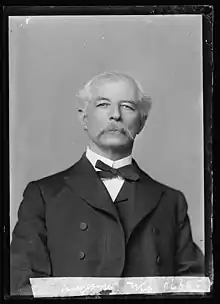John M. Pinckney
John McPherson Pinckney (May 4, 1845 – April 24, 1905) was a United States Representative from Texas who was shot and killed in Hempstead, Texas in 1905, making him the third member of the United States Congress assassinated in office.
Charles M. Pinckney | |
|---|---|
 | |
| Member of the U.S. House of Representatives from Texas's 8th district | |
| In office November 17, 1903 – April 24, 1905 | |
| Preceded by | Thomas H. Ball |
| Succeeded by | John M. Moore |
| Personal details | |
| Born | John McPherson Pinckney May 4, 1845 near Hempstead, Republic of Texas |
| Died | April 24, 1905 (aged 59) Hempstead, Texas, U.S. |
| Political party | Democratic |
Life and career
Pinckney was born near Hempstead in the Republic of Texas, he was raised on his family's farm near Fields Store. His father, Thomas Shubrick Pinckney, was crippled in a farming accident, leaving the young John to take on most of the work on the farm. His mother, Carolene (née Finney), died in 1861, leaving him the sole provider for his father and three siblings. None the less, Pinckney enlisted in Confederate States Army at age 16 and was attached with the 4th Texas Infantry in General John Bell Hood's Texas Brigade. After the end of the Civil War, he returned home and worked as a cotton weigher.
After being elected a justice of the peace, Pinckney decided to study law and was admitted to the bar in 1875, starting a practice in Hempstead. He was appointed district attorney for the twenty-third judicial district in 1890 which he served as for ten years until he was elected county judge of Waller County in 1900. Pinckney was then elected to the U.S. House of Representatives as a Democrat in a special election following the resignation of Thomas H. Ball in 1903. He was reelected to a full term in the House in 1904 and would serve in Congress until his death.[1]
Death
On April 24, 1905, a crowd of concerned citizens gathered in front of Waller County Courthouse in Hempstead to discuss a petition by the Prohibition League to Governor S. W. T. Lanham. The petition requested that Governor Lanham dispatch the Texas Rangers to enforce local prohibition ordinances, allowed under the state's local option law, due to insufficient enforcement by police and sheriffs. Tensions were high between "wets" (against prohibition) and "drys" (for prohibition) and supporters of both sides turned out for the gathering. Pinckney, who favored the petition, was first to speak and was routinely shouted down by opponents. Then J. N. Brown, a local lawyer and "wet" who was one of the people shouting at the congressman, pulled a pistol and began firing, as did his son Roland, and "drys" who were armed began firing back. Pinckney attempted to intervene to end the fight, but was shot in the back and killed when his brother Tom attempted to pull John away and protect him. Also killed were Tom Pinckney, J. N. Brown, and John Mills, a leader of the Prohibition League who succumbed to his wounds the next day. Pinckney's private secretary "Doc" Tompkins and Roland Brown were also shot, but survived. The entire gunfight lasted about thirty seconds and more than 75 bullets were found in the wall of the courthouse. Both John and Tom Pinckney were buried at Hempstead City Cemetery. Roland Brown was tried as an accomplice to the murders, but was acquitted when it was concluded that he had only taken out his pistol to protect his father.[1][2]
See also
References
- Marion, Nancy E.; Oliver, Willard M. (2014). Killing Congress: Assassinations, Attempted Assassinations and Other Violence Against Members of Congress. Lexington Books. pp. 29–38. ISBN 9780739183595.
-
- "Congressman Pickney Shot in a Texas Riot". The New York Times. April 25, 1905. Retrieved January 24, 2011.
- Amer, Mildred (March 14, 2002). "Members of the U.S. Congress Who Have Died of Other Than Natural Causes While in Office" (PDF). Congressional Research Service. Retrieved January 24, 2011.
Sources
External links
| U.S. House of Representatives | ||
|---|---|---|
| Preceded by Thomas H. Ball |
Member of the U.S. House of Representatives from Texas's 8th congressional district November 17, 1903 – April 24, 1905 |
Succeeded by John M. Moore |